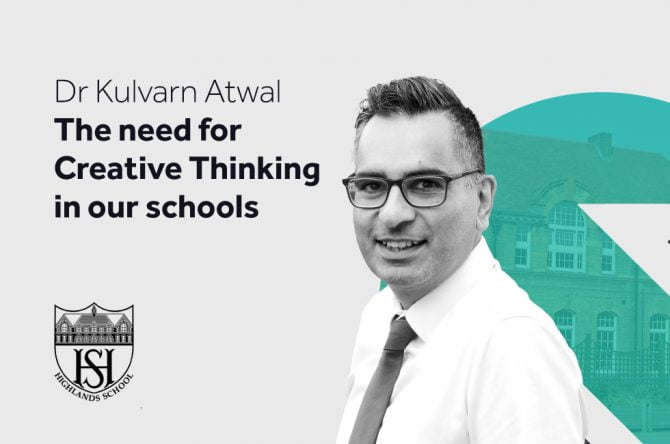As we move into the second year of our work at the Foundation for Education Development (FED) and following the launch of the FED National Education Consultation Report, we hosted a roundtable discussion seeking to answer the theme ‘What is creativity and why does it matter?’. The discussion centred on the Durham Commission on Creativity in Education.
We asked Dr Kulvarn Atwal, Head Teacher and author of ‘The Thinking School – Developing a Dynamic Learning Community’, to share his input into this roundtable discussion. In this powerful thinkpiece, Kulvarn suggests that there is ‘sufficient evidence to indicate that as a country England is falling behind education systems around the world where the development of creativity and critical thinking in students is taking centre stage’ and provides recommendations to create a greater emphasis on creative and critical thinking in education.
The need for Creative Thinking in our schools
As a headteacher of two primary schools in East London, I was recently asked to present a ‘practitioner’s’response to a recent report published by the Durham Commission on Creativity and Education and I was very pleased to do so. The place of creativity in our education system is a conversation where I believe we have to keep the fire burning. There is sufficient evidence to indicate that as a country England is falling behind education systems around the world where the development of creativity and critical thinking in students is taking centre stage. As a headteacher I’m also aware that my view on the importance of developing creative thinking is not reflected in all schools and certainly not sufficiently reflected within levers of government policy such as the National Curriculum or the recently revised OFSTED Inspection Framework.
A quick glance through the history of education demonstrates that there has been momentum within our education system to develop creativity through the curriculum. In 1999, the Robinson Report encouraged us to consider a national strategy for creative and cultural education. I still believe that we need to develop a national strategy that facilitates and supports school leaders and teachers to foster creative and critical thinking. 2009 saw the implementation of Personal Learning and Thinking skills (PLTs) which marked a significant shift away from a curriculum dominated by knowledge toward one which also seeks to promote wider skills. Now we have the Durham Commission on Creativity in Education (2019) which aims to identify ways in which creativity and creative thinking can play a larger part in the lives of young people.
So what does this mean for us in schools – not a lot at the moment. As a number of education systems across the world are investigating pedagogies and the effective assessment of creative thinking skills through the curriculum, we seem to have moved further and further towards a system that values the acquisition of knowledge. The acquisition of knowledge is very important for students, but this has to be balanced alongside the acquisition and development of creative thinking skills. The way in which school leaders are encouraged to lead their schools is heavily dominated by an accountability system that values outcomes in national tests (at the expense of wider personal and social development) within a rigid Inspection system. By rigid inspection system, I am arguing that the pressure on school leaders to lead their schools according to the demands of the inspection framework is immense. My most recent experiences with OFSTED Inspectors have indicated to me that knowledge acquisition is valued more than creative thinking. The mantra of ‘Know more Remember more’ is central and the word ‘creativity’ seems to be disregarded.
I will illustrate this with a straightforward example. I’m currently headteacher of a five form entry primary school and before I arrived, the school had been graded Requires Improvement by Ofsted. I’ve been headteacher of three schools and one of the first things I’ve done at each school I have led is to introduce what we call the ‘Creative Curriculum’. This curriculum enabled my first school to become one of the highest performing schools in London – basically, we teach in a way that develops children academically but also develops theirmotivation, curiosity and critical thinking skills. We recently hosted an advisory visit from current OFSTED inspectors. When we introduced our creative curriculum, just the title alone stopped one particular inspector in his tracks. He signalled for my Curriculum Lead to stop talking, explaining that the word ‘creative’ made ‘alarm bells’ ring in his head. This is not the only current inspector who has given us similar feedback. As an experienced headteacher, I may be able to withstand the external pressures facing our schools – many school leaders will not.
So what do we need to do? Well the Durham Commission makes a good start for us by defining creativity and critical thinking:
Creativity: The capacity to imagine, conceive, express or make something that was not there before.
Creative Thinking: A process through which knowledge, intuition and skills are applied to imagine, express or make something novel or individual in its contexts . . . underpinned by perseverance, experimentation, critical thinking and collaboration.
Teaching for Creativity: Explicitly using pedagogies and practices that cultivate creativity in young people.
If you are currently working in a school, take a moment to consider the extent to which your curriculum offer reflects this. Other countries in the UK, notably the development of the new national curriculum in Wales, arefurther advanced in their inclusion of creativity as a desired goal of education. The fact that PISA have signalled that the assessment of creative thinking is a priority for 2022 should be considered. The development of creative thinking in education across the globe is a movement that we in England can no longer ignore.
My first recommendation to develop a greater emphasis on creative and critical thinking in our schools is that we need to implement systemic change. Therefore, we need to have the development of creative thinking as central to our National Curriculum. This has to be underpinned by a strong emphasis on the development of our students’ social, personal and emotional skills. The second thing we need to do is adapt our inspection system and accountability framework to value the development of creativity in schools. Our inspection framework should also place greater value on the quality and leadership of teacher professional learning and development in schools. Finally if we want to develop our students as independent creative critical thinkers, weequally need to develop independent creative critical thinkers amongst our school leaders and teachers. We need to make it as easy as possible to enable staff teams to teach in a way that nurtures critical thinking – anational professional development programme that makes it as easy as possible for school leaders and their staff teams to work together to implement a curriculum that has at its heart a focus on the development of creativity in our students. We need to do this urgently because these are the skills I believe our young people urgently need to lead successful fulfilling lives in the future.



